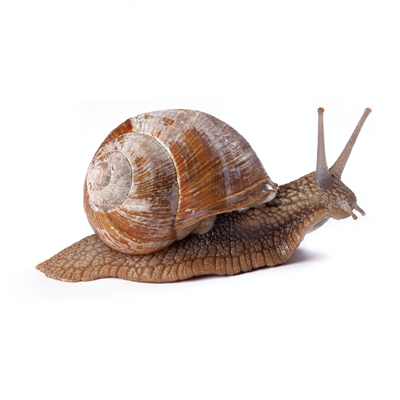
Color: Gray or brown.
Size: 1 to1-½-inch long.
Under rocks, decks, wood timbers such as railroad ties, mulch and where concrete meets grass.
At times they gather in large numbers in damp basements or crawlspace, leaving glistering mucous trail as they move about at night. They are basically plant feeder but sometimes deface buildings with their fecal material. They must have a large amount of moisture to survive, so they are most active during periods of wet weather, at night and in moist areas.
Slugs and snails chew large holes in foliage and may cause extensive damage to seedlings, tender, low-growing, leafy vegetables and ripening fruit, such as strawberries, artichokes, and tomatoes. Almost all garden vegetables, ornamental flowers, and some fruit trees, especially citrus are subject to attack.
Snails and slugs feed on both decaying and living plant material. Parts of plants that can be affected include leaves, stems and below-ground parts. They produce large, ragged holes and can completely consume young seedlings. A very wide variety of plant materials can be affected and they are especially troublesome on hostas, strawberries, lettuce and cabbage.
- Making sure that you remove all dead and rotting leaves, bricks, lumber piles from garden is another good idea as they can make good hiding places for both snails and slugs. Cultivating the soil in your garden frequently also helps as it unearths any slugs that may be hiding. Do not apply heavy layers of mulch around plants (1-3 inches is plenty).
- Another way to control slugs and snails is to make your home and garden as dry as possible. By keeping freshly cut grass it will eliminate the moisture and make it harder for them to get about. Pulling weeds from your garden is another way to do away with moisture within the garden. Water in the early morning instead of at night.
- Handpicking pests can make a sizeable dent in the population and is most productive in the evening, two hours after sunset. If handpicking is inconvenient, try trapping. Strips of cardboard, cabbage leaves, rocks, or plywood all make excellent traps for daytime collecting.
- Several types of barriers will keep snails and slugs out of planting beds. The easiest to maintain are those made with copper flashing and screen. Copper barriers are effective because it is thought that the copper reacts with the slime that the snail or slug secretes, causing a flow of electricity. Vertical copper screens can be erected around planting beds. The screen should be 6 inches tall and buried several inches below the soil to prevent slugs from crawling through the soil beneath the barrier.
- Beer traps can be made up of a plastic cup. They will be filled with little beer. Then it can be buried along with the soil. Slugs and snails are attracted to the beer and they usually fall and drown. Beer traps generally kill around 4-5 slugs and snails a night though slugs are the creatures that gets caught in these traps easily.
Manufacturer Recommended Products And Treatment For Snail & Slugs Control
Pests need food, water, and shelter. Often the problem may be solved just by removing these key items. Before even thinking about chemical pest control, it is important to be aware of
| Conducive Condition | Recommendation | |
| 1 | Tree branches on house | Keep tree branches away from house to reduce pest access |
| 2 | Firewood next to foundation | Keep firewood away from house to reduce pest harborage |
| 3 | Debris on crawlspace/next to foundation | Remove wood debris to reduce termite ha rborage area |
| 4 | Excessive plant cover, stump, etc. | Providing spacing between plant cover and structure |
| 5 | Soil above the foundation Ii ne | Keep soil below top of foundation to reduce harbo rage areas |
| 6 | Wood-to-ground contact | Keep soil from touching wood to eliminate termite access |
| 7 | Debris on roof/full gutter | Keep gutter & roof free of debris to reduce insect harborage |
| 8 | Standi ng water near/under structure | Eli minate standing water to reduce pest harbo rage |
| 9 | Mo isture problem under structure | Increase ventilation to reduce pest harbo rage area |
| 10 | Openi ngs at plumbi ng & electronics | Seal opening to reduce pest access |
| 11 | Excessive gaps at windows/doors | Seal gaps to reduce pest access |
| 12 | Lea ky plumb ing fixtures | Repair to reduce moisture for pests |
| 13 | Keep garbage cans covered | Covered to reduce attraction of insects of vertebrate pests |
| 14 | Mo isture damage wood | Repair rotten or damaged wood to reduce insect harborage |
| 15 | Grocery bags stored improperly | Seal paper sacks in containers to reduce i nsect ha rborage areas |
| 16 | Pet food unsealed or left out | Keep pet food in sealed containers and unavailable to pests |
| 17 | Excessive storage conditions | Keep storage areas uncluttered and manageable |
| 18 | Debris below kick plates | Remove kick plates to reduce rodent harborage |
1 product


